When the sun is shining, they glow with a bluish hue, standing out from the luminous white marbles, polished granites, and matte-black slates. There are not many of them in the Lower Cape cemeteries, but once one becomes familiar with their look, these grave markers are hard to miss.
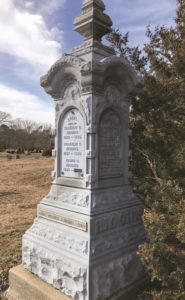
Briefly popular during the Victorian and Edwardian eras, cast zinc monuments — marketed with the fancy-sounding name “white bronze” — were popular for about 40 years, from 1874 to the beginning of World War I, and were a less expensive alternative to stone. Detractors considered them cheap imitations of natural stone and hardly a suitable way to honor a loved one.
Only one firm, the Monumental Bronze Company in Bridgeport, Conn., did original casting of white bronze grave markers, but numerous subsidiaries, including those in Chicago, Des Moines, New Orleans, and Canada, did assembly work and distribution.
Sold by salesmen using illustrated catalogues that offered customers an array of sizes, shapes, and prices, the monuments could be built from stock panels that featured popular religious, fraternal, animal, patriotic, and military emblems. Because each section of the monument was cast individually and joined with molten zinc, the combinations were limited only by one’s imagination.
The monument’s base was often finished to look like a block of rough stone. Custom panels with favorite religious verses could also be cast, thus personalizing the monument and adding to the variety of designs. It is safe to say that no two zinc monuments were alike. Resistant to rust, moss, and lichen, most zinc monuments have weathered the elements better than natural stone, though they are prone to stress fractures and a bulging at the base from top-heaviness. Because they are hollow, urban myths tell of family members hiding personal items, money, and, during Prohibition, supplies of liquor behind the panels.
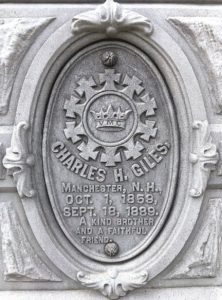
Interesting examples of these monuments can be found in several of Provincetown’s three contiguous cemeteries, Wellfleet’s Oakdale Cemetery, and Eastham’s Evergreen Cemetery. Perhaps one day a full inventory of these once trendy headstones might be taken.
In Provincetown’s Old Alden cemetery, a smallish zinc marker just off Cemetery Road draws one in with the epigraph “We have no home but Heaven.” Here is buried George Washington Readey (1833-1920), one of Provincetown’s more memorable characters, who, after a long life of adventure at sea beginning at age 11, came ashore where he worked odd jobs, married for the first time at age 56 to Mary Parks (it was her third marriage) and became town crier in 1885. Known as Professor Readey, his sea stories were legendary, none more so than the tale of his harrowing encounter with a sea serpent, a 300-foot creature covered in scales, with six eyes the size of dinner plates and an eight-foot horn crowning its head. Emerging from the surf at Herring Cove, it ambled up and over the dune past where Readey was hiding behind a bush and disappeared.
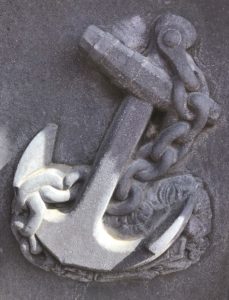
Readey signed an affidavit swearing to the veracity of his encounter and that he had not been “unduly excited by liquor or otherwise.” A 1915 Boston newspaper profile of Readey may, however, have cast some doubt on the story when it noted that he had “sprung” the tale on an innocent world some 20 years earlier.
In Provincetown’s Gifford Cemetery, an elaborate zinc headstone marks the grave of Capt. Isaac Baker Lewis, born here in 1831. One of 10 children born to Nathaniel Lewis and Azubah Snow, he was the brother of Capt. Thomas Lewis, who also has a white bronze headstone in the cemetery, and Bangs Atwood Lewis, owner of Lewis Wharf, purchased by Mary Heaton Vorse in 1913. Theatre fans know the wharf as the site where modern American theater began in 1916 with Eugene O’Neill’s one-act play Bound East for Cardiff.
The headstone for the Isaac Lewis family includes a panel for Isaac and his two wives, and a panel for the two young Betsys, who did not survive. A third panel remembers a young man, Charles H. Giles (1859-1889), who worked for Isaac Lewis and died of tuberculosis. The panel features a customized crown motif encircled by what appear to be crosses. Embedded in the crown are the letters V.M.C. An inscription, “A kind brother and a faithful friend,” suggests a fraternal affiliation and, indeed, the motto V.M.C. — Virtue, Mercy, Charity — indicates membership in the organization Royal Arcanum, a fraternal benefit society founded in Boston in 1877 and still active today.
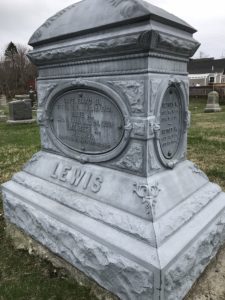
In Wellfleet’s Oakdale Cemetery, a white bronze monument remembers Capt. Noah Swett Higgins (1829-1894) and his wife, Abigail Newcomb (1831-1916). Both families had deep Wellfleet-Eastham roots, the Newcombs beginning with Thomas Newcomb’s marriage to Elizabeth Cook in 1693, and the Higginses beginning with Richard Higgins, one of the pioneer settlers of Eastham.
The headstone features motifs reflecting affiliations — the Masonic compass and an anchor — that were available to families to “personalize” their headstones. Having followed the sea from the age of eight, Noah S. Higgins spent decades as the master or owner of fishing and coastal vessels and in 1882 took command of the 100-ton schooner Freddie A. Higgins, a packet running between Wellfleet and Boston. Thereafter he retired to a farmer’s life.
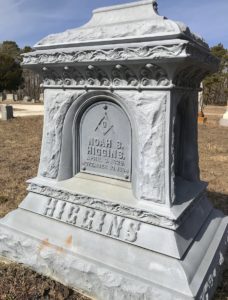
A prominent zinc monument in Eastham’s Evergreen Cemetery is an example of the “rough stone” technique used to mimic natural stone. It memorializes another branch of the Higgins family, that of mariner Beneiah Gill Higgins (1830-1876) and his wife, Maria Theresa Dill (1835-1902). The Dill family in Eastham originates with Medford-born Thomas Dill (1708-1761) who married Eastham-born Mehitable Brown in 1733. The Gill family on the Lower Cape appears to begin with the Eastham marriage of Scarlet Gill of Boston to Tabitha Nickerson of Chatham in 1747. The Dill-Gill family ties continue, just steps away from the Higgins monument, where a zinc headstone marks the grave of Maria’s brother, Theophilus Knowles Dill (1837-1890), a Civil War veteran. His monument features a motif of three chain links — signifying friendship, love, and truth — representing the Independent Order of Odd Fellows.
Though the era of white bronze monuments was short and the monuments are thinly scattered across the Lower Cape, their uniqueness may catch a visitor’s eye and encourage a closer examination of their workmanship and inquiry into the lives buried beneath. The “proof test,” a knock on the monument to determine if it is hollow, will confirm one’s discovery, though be prepared for the possibility that someone knocks back!



